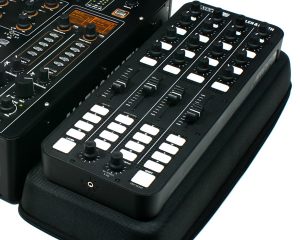
Pic: Key Music
It’s one of the big issues with digital/controller DJing: How do you set up in a DJ box when there’s hardly any room?
Some people think that club owners should let DJs bring what they want and find a way of dealing with it, but others feel you’re not a “real” DJ if you can’t turn up and use whatever’s there. And while both sets of people have got a point, most of us are looking for the middle ground..
One solution may be the kind of gear that gives you all the benefits of digital DJing without upsetting the DJ box you’re setting up in too much. Recently such equipment has become a reality for a growing number of DJs, a number that is only likely to grow more as new gear is released. So today we ask: Is the slimline digital DJ set-up the new choice for pro digital DJing?
Let’s be clear here. By slimline, we mean equipment that is specifically designed to slip into the tiniest of spaces while offering lots of what the digital DJ needs. Not shrunken so much as slimline, then – long and thin, which is the perfect size to slide in alongside existing gear. Faderfox, Denon, Reloop… all have small controllers, but slimline? So far there are only a handful…

It all started with Allen & Heath’s Xone:1D and Xone:2D DJ controllers. These were the first to have the slimline form factor, and the latter also offered a built-in sound card which meant DJs didn’t have to carry around a separate audio interface.
While not exactly lightweight, with these units arrived the concept of using slimline gear to perform a digital DJ set on. However, it is fair to say that they were always envisaged as part of a modular DJ system, where you’d have maybe a couple of these and a mixer to make a super-professional (and expensive) self-assembled digital DJ controller.
The Native Instruments Kontrol X1
Arguably the first big leap came with the Native Instruments Kontrol X1. Here was a DJ controller that specifically duplicated a set of controls for each “deck”, so you could glance at its panel and work out in seconds how you might use it to perform a full digital DJ set with no other gear.

While it was really meant to allow digital vinyl DJs to avoid having to touch their laptops, it was quickly adopted by “pure” digital DJs who didn’t need jogwheels or vinyl emulation and just wanted tight control over loops, effects and cueing etc.
However, with the Kontrol X1, there is no easy way of doing the “mixer” part. Sure you can control the decks, but you still need to be able to mix your music together. While you can map it to do what you want, it’s still not an obvious hack with this unit to try and incorporate mixing into your workflow. And also, it doesn’t have built-in sound. So you end up having to take a sound card too, and then plug your outputs into spare channels on the club’s mixer, using that to perform from.
Actually, once set up, what I just described is a really nice system – you glance at your laptop for your library, push buttons on the X1 to control the flow of the music, and use the house mixer to mix it. But there’s still a lot of setting up, including two (or four, if you’re a four-deck DJ) inputs into the mixer, which may be hard to achieve.
The Allen & Heath Xone:K2
Enter Allen & Heath’s new Xone:K2. This device majors on portability and mappability. It is slim, light and ready-cased, and when removed from the case it can be positioned on the same case to achieve the height of a standard DJ mixer. It’s plainly, like the X1, meant to be tucked next to a DJ mixer, but unlike the X1, it has a sound card built in, and a control surface that begs to be mapped to four decks, including mixing.

Plug its one master output into one spare channel of a house mixer, plug a USB into it from your laptop, and plug your headphones in the front, and you have a complete, four-deck DJ set-up that you could squeeze into the most cramped of DJ boxes (especially if you have a stand for your laptop that lets you elevate it easily above any existing equipment.)
While we haven’t properly tested the K2 yet (we’re due a review sample in the next few weeks), at first glance this seems to solve a lot of digital DJing’s problems. It’s a powerful unit that means you can come up with expressive custom mappings for your software to perform DJ sets way removed from two-decks-and-a-mixer; it is small, portable and easy to set up; and crucially, you can do everything, including all mixing (you’ll have to get used to the idea of no crossfader, but that’s easy enough – the crossfader is not obligatory for most DJing styles) from the one unit.
But is it the way forward?
The question is: Would you? Is this the way in-booth DJ set-ups are going? Can you cope with switching between decks? Would you feel silly DJing from just one (or two, if you’re wanting something a bit more complex) of these tiny units, or units like this? How much do jogswheels really matter to you, and how many do you need? Do you think we’ll see more manufacturers coming up with DJ booth-friendly digital control surfaces like this?
So, is slimline DJing about to become a major force in the digital DJ booth? I’d love to hear your thoughts in the comments.





![DJ Lighting, Using Headphones Only, Trance Mixing [Podcast] DJ Lighting, Using Headphones Only, Trance Mixing [Podcast]](https://cdn.digitaldjtips.com/app/uploads/2024/03/20175506/podcastwebsiteidea-150x150.jpg)


